- May 2016
-
virginia-anthology.org virginia-anthology.org
-
Spanish Dominions
Spain's colonies at this time included Venezuela and Colombia, so Crusoe's island is probably located off the northern coast of South America.
-
the eating of Grapes kill’d several of our English Men who were Slaves there, by throwing them into Fluxes and Feavers
There is no scientific basis for this supposition. More likely, the symptoms Crusoe describes were a result of scurvy, a condition caused by vitamin C deficiency and common among sailors.
-
Vapours
Physiologically, the four humors (sanguine, choleric, phlegmatic, melancholic) were thought to emit "vapors" that ascended to the brain and shaped one's temperament. When the humors were unbalanced, the vapors caused distemper and illness.
Tags
Annotators
URL
-
-
annotatingausten.sfsuenglishdh.net annotatingausten.sfsuenglishdh.net
-
Old Allen is as rich as a Jew — is not he?
This expression became common in the Middle Ages during a time where majority of the merchant class was Jewish, making the Jews among the most wealthy of the time (Dictionary of Phrase and Fable: R, 1894).
-
Nobody can fasten themselves on the notice of one, without injuring the rights of the other. I consider a country–dance as an emblem of marriage. Fidelity and complaisance are the principal duties of both; and those men who do not choose to dance or marry themselves, have no business with the partners or wives of their neighbours.”
I feel as though this quote says a lot about the how relationships were built in that time period but also in this story. Not only that but how the roles were set for men and woman. The man is so be the leader and the woman fallows. I do find it an interesting comparison with marriage being seen as dancing. In this example would you say Catherine and Mr. Tilney are dancing around each other?
-
“Do not be frightened, my dear Catherine,” whispered Isabella, “but I am really going to dance with your brother again. I declare positively it is quite shocking.
"A young woman did not dance more than two pairs of dances with the same man or her reputation would be at risk. Even two dances signaled to observers that the gentleman in question had a particular interest in her" (Maria Grace,“The High Stakes of Etiquette for Young Ladies in the Regency” ).
-
Captain
"Originally Captain-Lieutenant, becoming Captain in 1772. Lat. capitaneus "chieftain", from Lat. caput "head". Chieftain or head of a unit. As armies evolved his post came to be at the head of a company, which by the Sixteenth Century was usually 100 to 200 men. That seemed to be the number one man could manage in battle" (Harding, British Army Ranks).
-
fifty guineas
This would be the equivalent to roughly $2,000 today ("Currency Converter").
-
fifty thousand pounds
This would be the equivalent to roughly $2,000,000 today (“Currency Converter”).
-
country–dancing
"A rural or traditional dance, esp. in England and Scotland; spec. one in which couples begin by standing face to face in long lines" (OED).

-
cotillions
"The name of several dances, chiefly of French origin, consisting of a variety of steps and figures" (OED).
-
sword–case
"A case to hold a sword; in mod. use, a receptacle at the back of a carriage for swords, sticks, or other articles" (OED).
-
Curricle
"A light two-wheeled carriage, usually drawn by two horses abreast" (OED).

-
Did not we agree together to take a drive this morning?
“Do not accept an invitation to visit any place of public amusement, with a gentleman with whom you are but slightly acquainted, unless there is another lady also invited. You may, as a young lady, go with a relative or your fiancée, without a chaperon, but not otherwise” (Florence Hartley, The Ladies' Book of Etiquette, and Manual of Politeness, 173).
-
-
annotatingausten.sfsuenglishdh.net annotatingausten.sfsuenglishdh.net
-
Caractacus
A king of ancient Britons during the Iron Age who ruled from 43-50 AD, his successful attempts at expansion are believed to be the catalyst for the Roman invasion of Britain (Hill).
-
Alfred the Great
Alfred the Great was king of the southern Anglo-Saxon kingdom of Wessex and was known for social and educational reforms as well as military success. He is also the only English monarch known as "the Great" ("Alfred the Great").
-
Agricola
Agricola was a Roman statesman and soldier that governed over Britain and conquered large areas of northern England, Scotland, and Wales ("Agricola").
-
phaetons
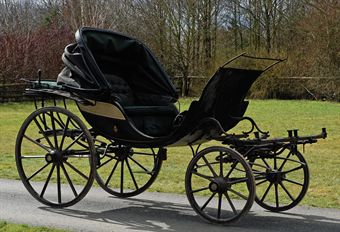 "A type of light four-wheeled open carriage, usually drawn by a pair of horses, and having one or two seats facing forward" (OED).
"A type of light four-wheeled open carriage, usually drawn by a pair of horses, and having one or two seats facing forward" (OED). -
the lady had asked whether any message had been left for her; and on his saying no, had felt for a card, but said she had none about her, and went away
Here, the narration refers to a “card”, which is more properly known as a calling card. A calling card -- or visiting card-- is defined as “a card bearing a person’s name and address, sent or left in lieu of a formal social or business visit; a visiting card” (OED). Originally a Parisian trend, these cards were either sent or left at a person’s place of residence to denote that acquaintance had formally visited while they were away or later intended to visit them (Robert Chambers, The Book of Days, np).
-
It was too dirty for Mrs. Allen to accompany her husband to the pump–room
The pump room -- better known as The Grand Pump Room -- was a building used for upper-class social gatherings and parties in Bath. It was especially popular during Jane Austen’s lifetime (Michael Forsyth, Bath, 68) (Mabel Van Niekerk, The Ancient Roman Cities of Bath and York, 24).
-
Going to One Wedding Brings on Another?
There is no evidence for a song with this title existing. During the Georgian period wedding hymns were often sung at parties that were not weddings, just for fun. However, the lyrics for this particular hymn does not exist. Austenites speculate that the author invented this title as an excuse for John Thorpe to suggest marriage to Catherine (ODP).
-
greatcoat
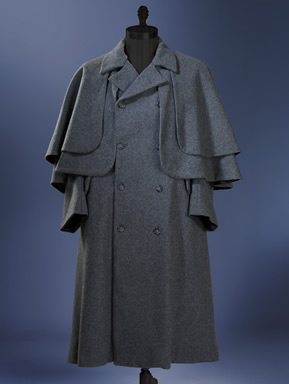
Greatcoats were a type of caped trench coat/ over coat that first came into use by the military in the 17th century, then evolved into casual wear for the upper class. They were made of thick wool and thus expensive for average people to own. However, by the time of the Industrial Revolution and Jane Austen's death, they were becoming more and more available to the middle and lower classes as well (ODP).
-
sprigged muslin
"Any of various lightweight cotton fabrics in plain weave. Also: a piece of such fabric; a dress or other article of clothing made of muslin" (OED).
From the 17th century to the late 18th century, muslin fabric was mostly imported from places like India. The fabric was used for dresses and curtains and was notably well liked for its simplicity; its ability to drape beautifully; and for the fabric's ability to take paint, dyes, and embroidery very well. Muslins were mostly worn by gentility in the color white. The color white was used to signify the gentility's wealthy lifestyle because white garments were harder to keep clean and were very expensive to constantly have laundered to maintain the pure white color. (Jane Austen’s World)
Here is an example of a sprigged muslin which is named for the muslin's unique design which resembles sprigs of leaves or flowers all over the dress:
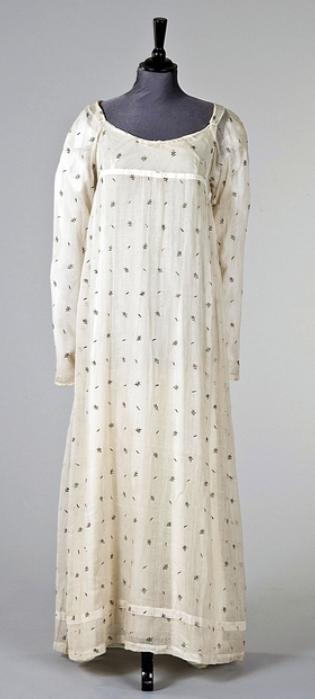
-
pump–room

"The Pump Room in Bath was built in the lower part of the town, and it was where those taking the “cure” would drink copious amounts of the warm spring water in order to effect a cure" (Austenonly). It was the place to be in high society.
-
-
educatorinnovator.org educatorinnovator.org
-
news articles on neighbor-hood displacements over the years to get students thinking further about underlying issues that affected them.
Gentrification -- or housing patterns -- is a great topic to explore with youth, precisely because it is both in the news and the stories represent historical patterns that can be studied deeply. Similarly, this is a teaching moment that can be about what is happening in the lives of youth in our classes and built on the strategies of placed-based education and writing. I started to pull some of this together around Renee Watson's Youth Adult novel Close To Home and Linda Christensen's work with the Oregon Writing Project and beyond with the Roots of Gentrification. See http://youthvoices.net/home1 I'd love to finish some of this curriculum development -- but only when teaching the material with students, not in the abastract.
-
-
annotatingausten.sfsuenglishdh.net annotatingausten.sfsuenglishdh.net
-
Catherine then ran directly upstairs, and watched Miss Thorpe’s progress down the street from the drawing–room window; admired the graceful spirit of her walk, the fashionable air of her figure and dress; and felt grateful, as well she might, for the chance which had procured her such a friend.
Here Austen is having Catherine admiring Isabella because of her charm that she possesses to her move up in society. She can see here how Isabella uses her appearance to win over people not to mention her manners. It brings up the thought of why there were so many balls during this time period. What was expected of women? The balls that Austen describes seem to be more like debutante ball. A Debutante ball is when younger women are brought into society so they can meet eligible men to marry but also be seen as ladies.
-
She liked him the better for being a clergyman, “for she must confess herself very partial to the profession”; and something like a sigh escaped her as she said it.
What is a clergyman? Jane Austen draws from her personal life in her novels pulling in her father’s job position. Clergyman in her novels a lot because it draws from her childhood of her father being one. Not only in Northanger Abby but also in Mansfield park its mentioned men to become clergymen. What is so significant to become of this position? According to Merriam-Webster a clergyman is defined as “a man who is a member of the clergy especially in a Christian church”. Breaking this down even more what does the word clergy mean? It means to be ordained in the church. The clergyman seems to be appear to be a minster who is a socialite among the wealthy. They would perform religious ceremonies in the Christian Church only but also were invited to socialize with the upper class at times.
Work Cited Miriam Webster.Com
-
The master of the ceremonies introduced to her a very gentlemanlike young man as a partner
The master of ceremonies was an official position in fashionable towns like Bath. Their job was to oversee the balls and parties. Their duties spanned from enforcing the rules and keeping the peace to making sure everybody was dressed correctly. As we see in this line, one of their most important jobs was to introduce young men and women (Austenonly, "The Master of Ceremonies: The Georgian Assembly Room, Part Four", https://austenonly.com/2013/02/28/the-master-of-ceremonies-the-georgian-assembly-room-part-four/ ).
-
There goes a strange–looking woman! What an odd gown she has got on! How old–fashioned it is! Look at the back.”
In response to the French Revolution, by the late 18th century, constricting, formal styles of dress, reminiscent of French aristocracy went out of fashion. Instead, looser styles of dress, inspired by classical Greek and Roman fashions, rose in popularity. Lightweight, sheerer materials, such as muslin were popular, as was an empire style waistline ("Lord Scott", An Introduction to Ladies' Fashions of the Regency Era, http://www.wemakehistory.com/Fashion/Regency/RegencyLadies/RegencyLadies.htm ).
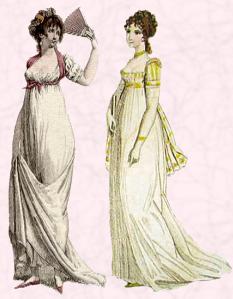
-
she longed to dance, but she had not an acquaintance in the room
During this period in England, men and women could not interact, much less dance together, unless they were formally introduced by somebody that they were both acquainted with (Maria Grace, The High Stakes of Etiquette for Young Ladies in the Regency, https://kimrendfeld.wordpress.com/2013/04/29/the-high-stakes-of-etiquette-for-young-ladies-in-the-regency/ ).
-
-
annotatingausten.sfsuenglishdh.net annotatingausten.sfsuenglishdh.net
-
turban
“A woman’s hat designed to resemble a turban” (OED). This was a fashionable headdress for women from the 1790's through the 1820's, inspired by English trade with India (Walford, Vintage Fashion Guild).

-
chandler
“A stand or support for a candle”; “[o]ne whose trade it is to make or sell candles”; or, “[i]n extended sense: [a] retail dealer in provisions, groceries, etc.: often somewhat contemptuous” (OED).<br>
 This implies that these were shops which primarily sold candles, but also sold various products like a convenience store.
This implies that these were shops which primarily sold candles, but also sold various products like a convenience store. -
a large Newfoundland puppy and two or three terriers
According to the American Kennel Club, The Newfoundland is a massive breed of English working dog, used for pulling nets, carts, and carrying loads. Newfoundlands also make excellent guard dogs. Henry's puppy would look something like this,
 but would grow to be a very large dog.
but would grow to be a very large dog.

Terrier is a group of breeds, originally bred to hunt vermin. Some examples include the West Highland White Terrier,
 Cairn Terrier,
Cairn Terrier,  and Norfolk Terrier.
and Norfolk Terrier. 
These dogs were kept not only as companions, but as useful parts of the household: the Terriers to control rats and other vermin, and the Newfoundland (when grown) for protection and labor. Even so, the Newfoundland’s sweet disposition would make for an ideal companion (American Kennel Club).
-
rubbed her temples with lavender–water
Lavender was used as an essential oil at the time (and even today) that would help to calm one's anxieties, whether through ingestion or scent. When rubbed on the temples, a person could better smell the oils to calm themselves (Lavender, Maria Lis-Balchin, 156).
-
curate
"A member of the clergy engaged as assistant to a vicar, rector, or parish priest", or "A minister with pastoral responsibility" (OED). In this context, Henry either has engagements (appointments) to keep with his assistant, or he has engagements (duties) of his own as a clergyman.
-
post–masters
"A person with official charge of post. The official at each of the stations or stages of a post-road; primary duty to carry mail to the next state" (OED).
-
cravats
“A long, narrow piece of linen, muslin, or other fine cloth, worn around the neck and either tied under the chin in a knot or bow with long flowing ends” (OED).
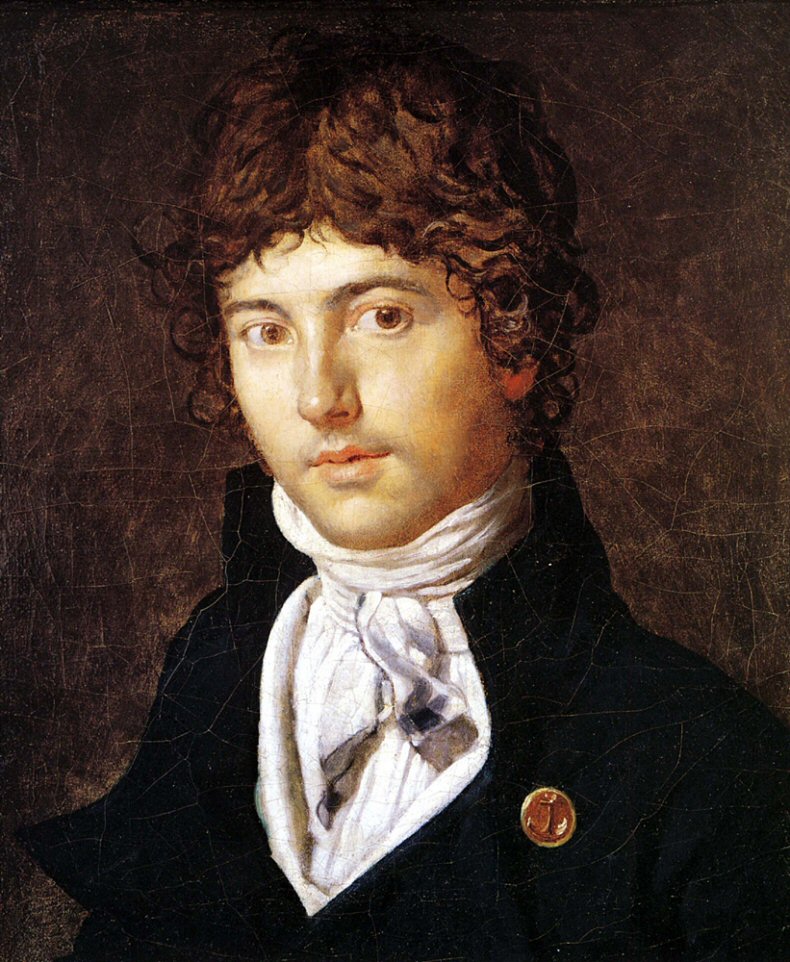
-
-
annotatingausten.sfsuenglishdh.net annotatingausten.sfsuenglishdh.net
-
all the dirty work of the house was to be done by two pair of female hands at the utmost
Catherine says in the novels only two women do the work, but in abbeys and castles of the period, there were about eighteen or more servants, ranging from cooks to laundry maids (countryhousereader, "The Servant Hierarchy", 2013).

-
a letter
"[...] letters were written on sheet[s] of paper that were folded and sealed [...] Envelopes were not used" (Jane Austen's World, Vic, "Letter Writing in Jane Austen’s Time").
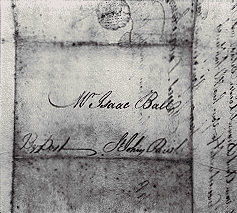
-
a bilious fever
When referring to disease, bilious is an overproduction of bile. Drawn from Hippocrates's now obsolete Theory of Four Humors, bile was also connected to a bitter and choleric personality (U.S. National Library of Medicine, The World of Shakespeare's Humors).
-
To poultice chestnut mare” — a farrier’s bill!
A remedy for cuts, swelling, and infection, specifically common for treatment of hoof abscesses. The herb poultice would be applied by the farrier (horseshoer), who in regency times often doubled as a general veterinarian and animal dentist (BookDoors).
-
pamphlets
Unlike the typical pamphlets we may think about today, in this era, pamphlets were used for political information.
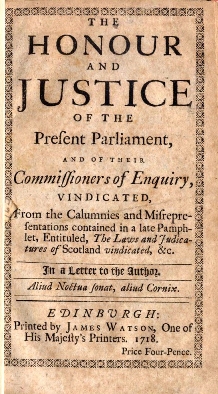
-
scullery
“A small room attached to a kitchen, in which the washing of dishes and other dirty work is done” (OED).


-
-
annotatingausten.sfsuenglishdh.net annotatingausten.sfsuenglishdh.net
-
the pump–room
A meeting place for upper-class people. Mrs. Allen's favorite place was situated closed to the main entrance of the Roman Baths. It is well-known for the power of its waters. The place is still popular today at tea time thanks to its restaurant ("Jane Austen World").

-
arch
Usually referring to, "women and children, and esp. of their facial expression: Slily saucy, pleasantly mischievous" (OED).
-
abbeys
An abbey is "A private residence, school, etc., formerly (part of) an abbey" (OED).
-
a traveling–chaise and four
A traveling chaise was a mode of quick transportation used by rich people, in the eighteenth century. This type of chaise was a closed carriage, which was equipped with four horses. The equipage, which was expensive, was generally composed of two men driving the two horses at the front and sometimes one postilion seated at the back ("Legacy Owensboro").

-
to be introduced to her
"To make known in person, esp. in a formal manner, with announcement of name, title, or other identification" (OED).
-
- Apr 2016
-
dropthatpdf.org dropthatpdf.orgARGUMENT1
-
seemeth
This is an archaic use of the -eth suffix for third-person indicative. This faded from usage during the Middle and Early Modern English periods.
-
-
www.nytimes.com www.nytimes.com
-
“Washington Crossing the Delaware.”
Here are a few extra interesting facts about the day of Washington crossing the Delaware.
-
- Mar 2016
-
virginia-anthology.org virginia-anthology.org
-
when a Malefactor who has the Halter about his Neck, is tyed up, and just going to be turn’d off, and has a Reprieve brought to him: I say, I do not wonder that they bring a Surgeon with it, to let him Blood that very Moment they tell him of it, that the Surprise may not drive the Animal Spirits from the Heart, and overwhelm him
Crusoe compares himself to a criminal condemned to be hanged, who receives a last-minute pardon or reduced sentence. Bleeding was thought to release adverse humors from the body, in this case those produced by the shock of the lightened sentence.
-
because they could not publickly sell the Negroes when they came home
Presumably because slave traders needed a special license from the Spanish or Portuguese crown.
-
Permission of the Kings of Spain and Portugal, and engross’d in the Publick, so that few Negroes were brought
In reality, the sugar and tobacco plantations of colonial Brazil were heavily dependent on slave labor and the trans-Atlantic slave trade. In 1888, Brazil became the last country in the Western world to abolish slavery.
-
Plantation and a Sugar-House
Portugal colonized Brazil in the late sixteenth century and instituted the lucrative sugar plantation system, which relied on African and Native American slave labor. In the seventeenth century, Brazil was the world's leading exporter of sugar.
-
Ducats
A gold or silver trade coin, formerly current in most European countries.
-
Twenty-two Days
This duration is actually remarkably short. Merchant vessels carrying slaves and cargo could take anywhere from four weeks to several months to travel from the Gold Coast to the Americas.
-
80 Pieces of Eight
Eighty Spanish dollars ("Pieces of eight" were so called because one was worth eight Spanish reales.)
-
all the Ships from Europe, which sail’d either to the Coast of Guiney, or to Brasil, or to the East-Indies
European merchant vessels would have carried salt, gold, and slaves away from Africa, and sugar and spices back from Brazil and the Indies respectively.
-
the River Gambia or Sennegall, that is to say, any where about the Cape de Verd
The area south of Morocco, near modern Senegal, was an epicenter for British trade in salt and slaves. [Insert map of west coast of Africa here.]
Tags
Annotators
URL
-
- Feb 2016
-
www.americanyawp.com www.americanyawp.com
-
As news of the Spanish conquest spread, wealth-hungry Spaniards poured into the New World seeking land and gold and titles
-
social and political advancement i
The racial system that was established in the new world was a racial hierarchy. The system worked based on the purity of ones blood. Then it was used as a status for political and social advancement.
-
-
www.casa-arts.org www.casa-arts.org
-
so that it is our duty to do justice and to restore to thefreemen their freedom, but it cannot be done i
I think that King Affonso was ok with the slave traders taking the lower class and the prisoners of war, because those people were worthless. The slave trade grew rapidly and more slaves were needed, the Portuguese ravaged the society and took what slaves they wanted. King Affonso opened a Pandoras box.
-
-
pages.shanti.virginia.edu pages.shanti.virginia.edu
-
too late to go Apprentice to a Trade, or Clerk to an Attorney
Apprenticeships in eighteenth century London often began around the age of fourteen, and lasted seven years.
(See De Munck, Bert, and Hugo Soly. "'Learning on the Shop Floor' in Historical Perspective." Learning on the Shop Floor: Historical Perspectives on Apprenticeship. Eds. Bert De Munck, Steven L. Kaplan, and Hugo Soly. (New York: Berghahn Books, 2007), p. 18)
-
middle State, or what might be called the upper Station of Low Life
Crusoe's origins reflect the reshaping of the social hierarchy to include an anomalous merchant middle class that belonged to neither the gentry nor the commons, and perhaps the need to create a literary space for readers of this educated class.
-
-
docs.google.com docs.google.com
-
Generation Chronology
I propose this as a thing. The idea is to create a list of people who have some significance to me whose lives overlap in time.
-
Synod of Whitby
Important to me because it looks like an significant date in the transition of Irish Christianity from the monasticism celebrated in Kenneth Clark's Civilization. For me the Irish monasticism focuses on Skellig Michael, most recently connected to the far, far away galaxy and Luke Skywalker
-
-
www.gateway-africa.com www.gateway-africa.com
-
Wave after wave she unleashed, until much of the land was underwater and many of the people were drowned.
Olokun seems very bitter and full of rage not caring about how many other she would kill
-
-
faculty.humanities.uci.edu faculty.humanities.uci.edu
-
A long time ago human beings lived high up in what is now called heaven.
The humans arrived in the world by coming from heaven.
-
When the boys had grown to man’s estate, they decided that it was necessary for them to increase the size of their island,
The twins created the world to become larger and modified the animals and plant life.
-
After much discussion the toad was finally persuaded to dive to the bottom of the waters in search of soil. Bravely making the attempt, he succeeded in bringing up soil from the depths of the sea. This was carefully spread over the carapace of the Turtle, and at once both began to grow in size and depth.
The animals helped the women when she came through the hole. The also helped prepare the earth for the women to live there.
-
-
www.bartleby.com www.bartleby.com
-
Then on the seventh day God rested, which is what we are suppose to do as well.
Tags
Annotators
URL
-
- Jan 2016
-
www.gateway-africa.com www.gateway-africa.com
-
Eshu demanded sacrifice be made to Obatala and himself before he would deliver the message. The people sacrificed some goats, and Eshu returned to the sky.
-
The next day he realized what he had done, and swore never to drink again, and to take care of those who were deformed, thus becoming Protector of the Deformed.
-
He did as he was told, whereupon the hen landing on the sand began scratching and scattering it about
-
In the beginning, there was only the sky above, water and marshland below. The chief god Olorun ruled the sky, and the goddess Olokun ruled what was below. Obatala, another god, reflected upon this situation, then went to Olorun for permission to create dry land for all kinds of living creatures to inhabit
So at the beginning was Africa was land of gods
-
-
faculty.humanities.uci.edu faculty.humanities.uci.edu
-
So he shook violently the various animals – the bears, deer, and turkeys – causing them to become small at once, a characteristic which attached itself to their descendants
-
When the boys had grown to man’s estate, they decided that it was necessary for them to increase the size of their island, so they agreed to start out together, afterward separating to create forests and lakes and other things.
-
When these were wearied they asked, "Who will volunteer to care for this woman?" The great Turtle then took her, and when he got tired of holding her, he in turn asked who would take his place. At last the question arose as to what they should do to provide her with a permanent resting place in this world.
-
It so happened that this chief’s daughter was taken very ill with a strange affection. All the people were very anxious as to the outcome of her illness. Every known remedy was tried in an attempt to cure her, but none had any effect.
she was very ill.
-
-
www.bartleby.com www.bartleby.com
-
And God said, Let us make man in our image, 1 Cor. 11.7 after our likeness: and let them have dominion over the fish of the sea, and over the fowl of the air, and over the cattle, and over all the earth, and over every creeping thing that creepeth upon the earth. 27 So God created man in his own image, in the image of God created he him; male and female created he them
God made the human a likeness and give him dominion over all animal
-
And God set them in the firmament of the heaven to give light upon the earth, 18 and to rule over the day and over the night, and to divide the light from the darkness: and God saw that it was good
-
In the beginning God created the heaven and the earth.
God did everthing
-
-
www.americanyawp.com www.americanyawp.com
-
In the American Southwest sometime between the years 900 and 1300 ancient Puebloan peoples built a large civilization sustained by advanced irrigation and a vast trading network linking goods from as far as Central Mexico and the Mississippi River
-
Several expansive civilizations in the Midwest and Southwest demonstrated the potential for large-scale Indian civilizations.
-
But native populations adapted: they fished, hunted small mammals, and gathered nuts and berries.
The native adapted fast or how many years past?
-
Agriculture arose sometime between nine- and five-thousand years ago, almost simultaneously in the Eastern and Western Hemispheres. Mesoamericans in modern-day Mexico and Central America first domesticated maize and and developed perhaps the hemisphere’s first settled population around 1,200 BCE.
How did they get the maize?
-
Nomadic hunter-gatherers, they traveled in small bands following megafauna–enormous mammals that included mastodons and giant horses and bison–into the frozen Beringian tundra at the edge of North America.
The native american descend from Asia?
-
Hunters across the hemisphere preyed on plentiful game and natural foods and the population boomed
-
-
www.sfchronicle.com www.sfchronicle.com
-
Recently rediscovered photos from The Band's 1976 Last Waltz concert. link
-
-
www.muslimheritage.com www.muslimheritage.com
-
Site on pre-Renaissance Muslim contributions to knowledge. https://twitter.com/HeritageMuslim
-
-
factually.gizmodo.com factually.gizmodo.com
-
A popular list of assertions about "100 years ago" is not very accurate -- partly because the same list is recirculated without changing anything but the years.
-
-
nautil.us nautil.us
-
The story of Walter Pitts and Warren McCulloch, whose theory of brain function was followed by John von Neumann's design for the stored program computer.
-
-
er.educause.edu er.educause.edu
-
George Dyson, Turing's Cathedral: The Origins of the Digital Universe (New York: Pantheon Books, 2012), ix.
-
-
www.whitehouse.gov www.whitehouse.gov
-
four big questions
How do these compare to Roosevelt's "Four Freedoms"?
-
-
www.hollywoodreporter.com www.hollywoodreporter.com
-
David Bowie died 10 January 2016 after an 18-month battle with cancer. On 8 January, his birthday, he released his 25th album, Blackstar.
-
-
constitutioncenter.org constitutioncenter.org
-
the spring of 1787.
What happened at this time in US history?
-
-
www.nypl.org www.nypl.org
-
180,000 public domain items from the New York Public Library Digital Collections. Photographs, stereoscopic photos, illustrations, maps, ancient texts, manuscripts, historical correspondence, sheet music, and more!
http://api.repo.nypl.org/<br> https://github.com/NYPL-publicdomain/data-and-utilities<br> API and metadata
http://nypl.org/publicdomain<br> More info, and some projects that use the API.
-
-
digitalcollections.nypl.org digitalcollections.nypl.org
-
albums produced between 1908 and 1913 by developers and the real estate industry to entice potential middle and upper class tenants to New York City’s “principal high class apartment houses,” declares one volume’s subtitle. Each featured apartment house is briefly described, and illustrated with an exterior photograph and one or more floor plans.
Mauricio Geraldo made a game out of the floor plans.<br> http://publicdomain.nypl.org/mansion-maniac/<br> http://github.com/nypl-publicdomain/mansion-maniac
-
- Dec 2015
-
motherboard.vice.com motherboard.vice.com
-
The collapse of the Tacoma Narrows bridge in 1940 was caused by flutter, not resonance. And sometimes the film is played too fast.
-
-
www.theguardian.com www.theguardian.com
-
Maria Anna (called Marianne and nicknamed Nannerl) was – like her younger brother – a child prodigy. The children toured most of Europe (including an 18-month stay in London in 1764-5) performing together as “wunderkinder”. There are contemporaneous reviews praising Nannerl, and she was even billed first. Until she turned 18. A little girl could perform and tour, but a woman doing so risked her reputation.
-
-
blog.stephenwolfram.com blog.stephenwolfram.com
-
Long article by Stephen Wolfram on the history of Ada Lovelace, Charles Babbage, and his calculating machines.
-
-
blog.dshr.org blog.dshr.org
-
www.americanyawp.com www.americanyawp.com
-
The effects of slavery endured long after emancipation.
The effects of slavery had been ingrained too deep for it to get ineffective that soon.
-
Yet the end of legal slavery did not mean the end of racial injustice.
Despite the legal end of slavery, blacks were still not treated as equals by white.
-
Lincoln won twenty-two states, and McClellan only managed to carry three: New Jersey, Delaware, and Kentucky.19
What a huge difference!
-
In a time when the average woman gave birth to eight to ten children in her lifetime,
That's too many kids for one woman to give birth to!
-
In the North, the conditions in hospitals were somewhat superior.
thanks to the women!
-
It is a common misconception that amputation was accompanied without anesthesia and against a patient’s wishes.
-
Around 1862 both armies began to dig latrines rather than rely upon the local waterways.
Lesson learnt the hard way!
-
Tuberculosis, measles, rheumatism, typhoid, malaria, and smallpox spread almost unchecked among the armies.
-
arrested all rebellious women as prostitutes.
Such a harsh and demeaning term to be used for women who were fighting for their country.
-
The working class citizens of New York felt especially angered as wealthy New Yorkers paid $300 for substitutes, sparing themselves from the hardships of war.
The rich always get away for everything that's probably the reason why they live for so long.
-
The Gettysburg Campaign was Lee’s final northern incursion and the Battle of Gettysburg remains the bloodiest battle of the war, and in American history, with 51,000 casualties.
-
There was never any doubt that black laborers and camp servants were property.
Black were not even considered living beings since a living being can never be referred to as one's "property".
-
Gooding argued that, because he and his brethren were born in the United States and selflessly left their private lives and to enter the army, they should be treated “as American SOLDIERS, not as menial hirelings.
-
African American soldiers in the Union army endured rampant discrimination and earned less pay than white soldiers, while also facing the possibility of being murdered or sold into slavery if captured by Confederate forces.
African Americans never really felt the true sense of freedom!
-
In order to avoid the issue of the slaves’ freedom, Butler reasoned that runaway slaves were “contraband of war,” and he had as much a right to seize them as he did to seize enemy horses or cannons
The extreme measures that were taken in desperation of not letting the eradication of slavery occur.
-
. War meant the possibility of disruption to their cotton produced on the backs of slave labor, and disruption could have catastrophic ramifications in commercial and financial markets abroad.
-
“I think to lose Kentucky is nearly the same as to lose the whole game.
Tells the significance of winning over Kentucky.
-
. Like an anaconda snake, they planned to surround and squeeze the Confederacy.
Perfect analogy.
-
Committee of Thirteen
It was a committee of thirteen individuals that was formed to investigate the possibility of a "plan of adjustment" that might solve the growing secession crisis.
-
sine qua non
something that was absolutely needed. In this case it was SLAVERY.
-
while doing little else to address the issues tearing the country apart.
The issues that needed the utmost attention were being ignored.
-
the Republicans were hardly unified around a single candidate themselves
Finding unity among human race has always been a rare incidence.
-
The nation’s oldest party had split over differences in policy toward slavery.
One party wanted to eradicate slavery while the one wanted to keep it going.
-
The American Civil War, the bloodiest in the nation’s history, resulted in approximately 750,000 deaths.1 The war touched the life of nearly every American as military mobilization reached levels never seen before or sinc
-
-
talkingpointsmemo.com talkingpointsmemo.com
-
Trump's embrace of racism, anti-Mexican immigrant bigotry and Islamophobia is largely opportunistic. My only hesitation in calling it cynical is that I think Trump may be the type who, once he finds something convenient to say, then starts to believe it.
-
-
math.mit.edu math.mit.eduCT4S.pdf5
-
As mentioned above category theory has branched out into certain areas of scienceas well. Baez and Dolan have shown its value in making sense of quantum physics, itis well established in computer science, and it has found proponents in several otherfields as well. But to my mind, we are the very beginning of its venture into scientificmethodology. Category theory was invented as a bridge and it will continue to serve inthat role.
-
All this time, however, category theory was consistently seen by much of the mathe-matical community as ridiculously abstract. But in the 21st century it has finally cometo find healthy respect within the larger community of pure mathematics. It is the lan-guage of choice for graduate-level algebra and topology courses, and in my opinion willcontinue to establish itself as the basic framework in which mathematics is done
-
In 1980 Joachim Lambek showed that the types and programs used in computerscience form a specific kind of category. This provided a new semantics for talking aboutprograms, allowing people to investigate how programs combine and compose to createother programs, without caring about the specifics of implementation. Eugenio Moggibrought the category theoretic notion of monads into computer science to encapsulateideas that up to that point were considered outside the realm of such theory.
-
Bill Lawvere saw category theory as a new foundation for all mathematical thought.Mathematicians had been searching for foundations in the 19th century and were reason-ably satisfied with set theory asthe foundation. But Lawvere showed that the categoryof sets is simply a category with certain nice properties, not necessarily the center ofthe mathematical universe. He explained how whole algebraic theories can be viewedas examples of a single system. He and others went on to show that higher order logicwas beautifully captured in the setting of category theory (more specifically toposes).It is here also that Grothendieck and his school worked out major results in algebraicgeometry.
I haven't studied toposes, but I can at least see how introductory algebraic geometry, i.e. the study of Groebner bases, relates to propositional logic.
-
The paradigm shift brought on by Einstein’s theory of relativity brought on the real-ization that there is no single perspective from which to view the world. There is nobackground framework that we need to find; there are infinitely many different frame-works and perspectives, and the real power lies in being able to translate between them.It is in this historical context that category theory got its start.
-
-
www.americanyawp.com www.americanyawp.com
-
The first and most ominous sign of a coming sectional storm occurred over debates surrounding the admission of the State of Missouri in 1821.
-
Abraham Lincoln won the 1860 contest on November 6, gaining just 40% of the popular vote and not a single southern vote in the Electoral College.
-
It was Kansas that at last proved to many northerners that the sectional crisis would not go away unless slavery also went away.
Finally they understood the main root of the problem.
-
“Bleeding Kansas” was the first place to demonstrate that the sectional crisis could easily, and in fact already was, exploding into a full-blown national crisis.
-
the anti-immigrant movement simply could not capture the nation’s attention in the ways the antislavery movement already had.
-
The year 1855 nearly derailed the northern antislavery coalition
-
In the words of Amos Adams Lawrence, “We went to bed one night old-fashioned, conservative, compromise Union Whigs & woke up stark mad Abolitionists.”13
shows that stark change of events
-
Ordinary Americans in the North increasingly resisted what they believed to be a pro-slavery federal government on their own terms.
-
One measure of the popularity of antislavery ideas came in 1852 when Harriet Beecher Stowe published her bestselling antislavery novel, Uncle Tom’s Cabin.
Antislavery was becoming more and more popular.
-
The 1852 Presidential election gave the Whigs their most stunning defeat and effectively ended their existence as a national political party.
I am glad that Whig's party got wiped out.
-
The Fugitive Slave Act created the foundation for a massive expansion of federal power, including an alarming increase in the nation’s policing powers
-
By 1850, California wanted admission as a free state.
-
a women’s rights movement also got underway in July at Seneca Falls, New York
At last!
-
Left unrepresented, antislavery Free Soil leaders swung into action.
Since they were not left any other choice.
-
Douglass grew up, like many enslaved people, barely having known his own mother or date of birth
How unfortunate could it be to not know one's mother and date of birth.
-
But the Liberty Party also shunned women’s participation in the movement, and distanced themselves from visions of true racial egalitarianism.
As if antislavery movement was not big of a deal to handle.
-
whites never intended them to be citizens of the United States
Blacks are being referred to as "them"
-
Even seemingly simple and straightforward phrases like “All Men Are Created Equal” were hotly contested all over again
Whites did not think of blacks as their equal. What a shame!
-
laws tried to keep blacks out of the West entirely.
Law should never cast out a certain group of people based on their skin color!
-
Kentucky and Tennessee emerged as slave states, while free states Ohio, Indiana (1816) and Illinois (1818) gained admission along the river’s northern banks.
-
Thomas Jefferson, believed that slavery was a temporary institution and would soon die ou
Slavery was never built as a temporary institution.
-
Vermont coming into the Union as a free state, and Kentucky coming in as a slave state
-
communities that would continually reignite the antislavery struggle.
These were former enslaved Africans.
-
English political theorists, in particular, began to re-think natural law justifications for slavery.
How inhuman is it for a certain group of humans to try to think of a natural law to justify their repulsive act of enslaving other humans?
-
They generated tremendous wealth for the British crown
The enslaved workers
-
Southerners feared that without slavery’s expansion, the abolitionist faction would come to dominate national politics and an increasingly dense population of slaves would lead to bloody insurrection and race war.
Northerners and Southerners had the same motive despite the opposite mentalities and thought processes.
-
Slavery’s history stretched back to antiquity. Prior to the American Revolution, nearly everyone in the world accepted it as a natural part of life.
-
Congress reached a “compromise” on Missouri’s admission, largely through the work of Kentuckian Henry Clay
-
Revolutionaries in the United States declared
“All men are created equal,”
-
- Nov 2015
-
www.thelizlibrary.org www.thelizlibrary.org
-
I cannot but laugh
John Adams is not taking his wife's concerns seriously.
-
Do not put such unlimited power into the hands of the husbands.
Husbands tend to take their wives as their properties and not as other halves.
-
"I long to hear that you have declared an independency
Abigail says it in a sense where the independence would only affect her husband and not her.
Tags
Annotators
URL
-
-
www.americanyawp.com www.americanyawp.com
-
former slaves fled with the British army.
in hopes of getting freedom.
-
Americans began to create their own manufactures, no longer content to rely on those in Britain
There were upsides and downsides.
-
Americans celebrated their victory, but it came at great cost
-
By 1781, the British were also fighting France, Spain, and Holland.
-
he developed his own logic of warfare
to split the armies into small groups
-
The Congress approved the document on July 4, 1776
The document of Independence.
-
dangerous and ill-designing men
traitors
-
Congress was in the strange position of attempting reconciliation while publicly raising an army.
The Congress was two-faced and untrustworthy.
-
The Congress struck a compromise
When everything else failed, Congress had no other option but to come to an agreement.
-
the Coercive Acts fostered the sense of shared identity created over the previous decade
This Act backfired
-
Because women were often making decisions regarding which household items to purchase, their participation in consumer boycotts held particular weight
-
By buying the tea, even though it was cheaper, colonists would be paying the duty and thereby implicitly acknowledging Parliament’s right to tax them.
explains the reason for tea resistance.
-
. A new sense of shared grievances began to join the colonists in a shared American political identity.
Sharing the same sense of pain unites people more than sharing the same joy.
-
bloodthirsty British soldiers with grins on their faces firing into a peaceful crowd.
worked perfectly well to aggravate the situation even further.
-
When a small number of soldiers came to the sentry’s aid, the crowd grew increasingly hostile until the soldiers fired.
shows the hostility the colonists felt towards the Britishers.
-
colonists, once again, resisted.
Since the protest against the Stamp Act did work, the colonists thought of solving every issue with resistance.
-
In New York City, the inhabitants raised a huge lead statue of King George III in honor of the Stamp Act’s repeal.
-
However, the colonists rejected the notion of virtual representation, with one pamphleteer calling it a “monstrous idea
-
This led, in part, to broader, more popular resistance.
referring to Stamp Act
-
Stamp Act
The first internal tax levied directly on American colonists by the British government.
-
The King forbade settlement west of the Appalachian Mountains in an attempt to limit costly wars with Native Americans.
They could not afford spending any more money on war.
-
Britain now controlled the North American continent east of the Mississippi River, including French Canada.
The Seven Years' War grew Britain's power in unimaginable ways.
-
Both Locke and Whitefield had empowered individuals to question authority and to take their lives into their own hands.
Both education and religion played the key role in changing people's train of thought.
-
Education would produce rational human beings capable of thinking for themselves and questioning authority rather than tacitly accepting tradition.
Educating people is the initiate step a government could take towards better future.
-
Perhaps no single philosopher had a greater impact on colonial thinking than John Locke
-
Colonial political culture in the colonies also developed differently than that of the mother country
So each colony had their own culture?
-
Samuel Adams, in the Boston Gazette, described the colonies as each being a “separate body politic” from Britain.
-
Constant war was politically consuming and economically expensive.
War always has a negative impact on the economy.
-
But the Revolution was as paradoxical as it was unpredictable
-
Throughout the eighteenth century, colonists had developed significant emotional ties with both the British monarchy and the British constitution
this explains why Benjamin Rush felt the way he did.
-
-
historymatters.gmu.edu historymatters.gmu.edu
-
I am not of opinion that in giving Land to the English, we deprive ourselves of the use of it, on the Contrary, I think we shall share it with them,
I really am impressed by his thought process.
-
Neither will the Generous Inflict a Punishment without a Crime.
-
eternal marks traced
Every word said out loud was written down so that no one could alter it later on.
-
No group—European or Indian—held sovereign power, and diplomatic, military, trading, and social exchanges continued for much of the eighteenth century.
Only if this could have lasted for a longer period of time.
-
Native Americans living in interior regions maintained greater control over their lands and culture
These were the peaceful times before the invasion of the White.
Tags
Annotators
URL
-
-
genius.com genius.com
-
the lower People,
referring to the poor lower class people.
-